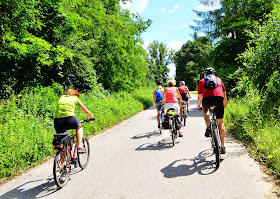Well that's it - the last Ramone died today. Joey, Dee Dee, Johnny and now Tommy - all four original members of the Ramones - the incredibly influential New York punk rock band - have shuffled off this mortal coil. One. Two. Three. Four.
Tommy Ramone, born Tamas Erdelyi in Budapest, died today aged 62 of bile duct cancer. He was predeceased by Joey, aged 49 (2001), Dee Dee, aged 50 (2002) and Johnny, aged 55 (2004).
The cultural and historical significance of the Ramones is such that Tommy's death was
the third news item on the BBC this morning.
I've been thinking about the Ramones of late - maybe its because the coffee machine in our office sounds like the intro to
Chain Saw - maybe its because so many young people around Warsaw
of my children's age are wearing Ramones T-shirts. When I was their age, these guys changed the way we looked at music for ever. Bye-bye triple concept albums by Yes and Pink Floyd warbling about albatrosses.
And I've been listening to the Ramones a lot in recent weeks - mainly the first three albums - with the band's original line-up. All of my favourite Ramones songs are from the first three albums. Below: the cover of the band's first album, Ramones. From left to right: Johnny (John Cummings), Tommy (Tamas Erdelyi), Joey (Jeffrey Hyman), Dee Dee (Douglas Colvin). Straight-leg jeans, sneakers, leather bomber jackets - and these guys played their first gig 40 years ago! [To this day, black leather bomber jackets in Poland are called
ramoneski.]
Below: the Ramones logo, based on the Seal of the President of the US. Today shopping at Auchan I spotted a grey-haired man my age wearing a red T-shirt bearing this logo. We exchanged sombre nods - acknowledgement that an era has come to an end.
I'm proud to say I saw the Ramones in concert twice - once on the legendary Rainbow New Year's eve show (31 December 1977), recorded as a live album (
It's Alive) and in this YouTube clip,
below:
The second time was the day after my 21st birthday at Warwick University, Coventry, where I was studying. I happened to interview the band for University Radio Warwick (photo
below - that's me on the left, with Johnny Ramone, right) - photo by Nick Morris. By October 1978, Tommy Ramone had been replaced by Marky on drum duties; he stayed on to manage the band and work co-producing their fourth album.
The Ramones made little impact on the mainstream at the time they appeared in the mid-70s, their first album,
Ramones, released in April 1976, only reached no. 111 in the Billboard charts. In Britain, however, this 12-inch vinyl platter changed a generation for good.
They inspired the punk rock bands with the message that not knowing how to play more than three chords was not actually an obstacle if you had something to say and could say it with conviction and energy. The Sex Pistols, Clash, Damned and indeed the nearest thing West London had to the Ramones, the Lurkers, would not have got going in the direction they did were it not for the Ramones leading the way across the Atlantic.
I remember cruising up to the polling station on the Argyle Road in May 1983 in my big black GAZ M-21 Volga, intending to vote for Mrs Thatcher. I switched on the car radio. Radio 1 was playing the Ramones -
Sheena is a Punk Rocker. The song changed my voting intentions. I could not vote for Mrs Thatcher, thus betraying the very essence of punk rock. So minutes later, I placed my 'X' against the name of the Liberal candidate for Ealing North (wasted vote, as it happened).
Mr Dembo's Ramones Pick-List (grab these off YouTube). Hardly any song exceeds two and half minutes. An asterisk after the track name suggests
essential listening.
Ramones (April 1976)
Blitzkrieg Bop*
Beat on the Brat
Judy is a Punk
Chain Saw*
I Don't Wanna Go Down to the Basement
Loudmouth*
Havana Affair*
Listen to My Heart
53rd & 3rd*
Today Your Love, Tomorrow the World*
Ramones Leave Home (January 1977)
Glad to See You Go*
Gimme Gimme Shock Treatment
Sheena is a Punk Rocker*
Suzy Is a Headbanger
Pinhead
Commando*
You're Gonna Kill That Girl
Rocket to Russia (November 1977)
Cretin Hop*
Rockaway Beach*
I Don't Care
We're A Happy Family
Teenage Lobotomy*
I Wanna Be Well
Ramona
And of course,
It's Alive (if you have the double live album, check out the gate-fold - you'll see me down in the front row, I'm uh, I'm down there somewhere... This performance was amazing for the speed, the adrenaline - each short song played even faster - averaging about a minute and half - and no pause between songs. After the last beat ONE TWO THREE FOUR and we're into the next one. One of the greatest live rock albums of all time ever.
This did not happen accidentally. Johnny was the disciplinarian, demanding long rehearsals, building up the band's incredible stamina. Dee Dee and Joey provided the comic-book schlock teen lyrics, the speeded-up surf sounds, the stripped-down harmony. Total heaviosity combined with sing-along melodies. And Tommy held the whole thing together.
Coencidentally, Tommy in his pre-Ramones days worked as assistant engineer on Jimi Hendrix's
Band of Gypsies album, which contained
Machine Gun, which features as the soundtrack of the greatest moment in the Coen Brother's greatest movie,
A Serious Man (
The Goy's Teeth sequence).
This time three years:
Midsummer evening, Jeziorki
This time four year:
Feininger in Kraków
This time five years ago:
Agricultural notes from Jeziorki
This time six years ago:
Stormy Sunday - lightning photos
This time seven years ago:
Peacocks wow tourists in Łazienki Park





















































